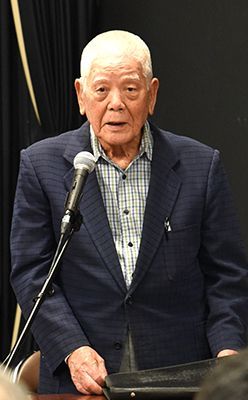Battle of Okinawa was “hell on earth”: A veteran’s vow to peace

Photograph: Gima shares his experience of the Battle of Okinawa as a former Tekketsu Kinnōtai solider at the Himeyuri Peace Hall in Asato, Naha City, on April 13.
April 4, 2019 Ryukyu Shimpo
Friends of the Okinawa Prefectural Peace Memorial Museum hosted an educational 5K peace walk in Naha City on April 13. The course stretched from “Sugarloaf Hill”, which was the bloodiest battlefield during the Battle of Okinawa, to Shuri Park, where the former underground headquarters of the Japanese 32nd Army is located.
Akio Gima, 91, delivered a talk at the Himeyuri Peace Hall in Asato, Naha City.
Gima fought in the Battle of Okinawa as a Tekketsu Kinnōtai (Iron and Blood Imperial Corps) solider when he was a first-year student at the Okinawa Normal School.
Gina said of the battle, “It was hell on earth.
Construction of military bases, which causes wars, should not be permitted.”
As part of the field fortification unit, Gima was working on a cave near Shuri Castle.
It was when the troop retreated north on May 27, 1945, that he witnessed the war.
“Exiting the cave, there were bodies everywhere, on the streets and in intersections, stacked on top of each other. It looked like hell on earth, there’s no other way to describe it.”
It took Gima nearly three days to reach Mabuni, Itoman City. He remembered “feeling alive for the first time,” upon seeing a sugarcane field.
It wasn’t long before the American troops began its attack and the area was scorched to nothing.
Injured Japanese soldiers lay on the streets begging to be killed, but Gima had “lost sense of humanity.
I just kept heading towards the shore.”
Along the shore, Japanese soldiers and locals were taking cover. Once they were surrounded by American soldiers, they had no choice but to surrender.
“I was ready to die. We were taught to be. I feel guilty to be the only one surviving while my friends lost their lives.”
When the war ended, Gima became an elementary school teacher. Today, he participates in the protest against the construction of the new base in Henoko, Nago City, every Monday morning at the Asato intersection.
Gima said, “People are what start and end wars. I have to share my own experience with the new generation.”
(English translation by T&CT and Monica Shingaki)
Previous Article:Okinawa Shogaku Junior High School receives MEXT Minister Prize for largest number of Eiken passers
Next Article:Second-generation Okinawan descendant meets with her mother’s relatives in Okinawa
[Similar Articles]
- “War is a mistake” 94-year-old survivor of the Battle of Okinawa decries Russian invasion on Naha’s streets
- 90-year old former student recalls history of Battle of Okinawa remains in Shuri Castle grounds
- Former Himeyuri student delivers final lecture at museum
- Descendants of the Himeyuri Peace Corps visit the battlefield where the student nurses were mobilized for the 30-year anniversary of the Himeyuri Peace Museum
- Walking Study Tour on the Battle of Okinawa From the Haebaru Army Hospital Cave to Itokazu Cave
 Webcam(Kokusai Street)
Webcam(Kokusai Street)


